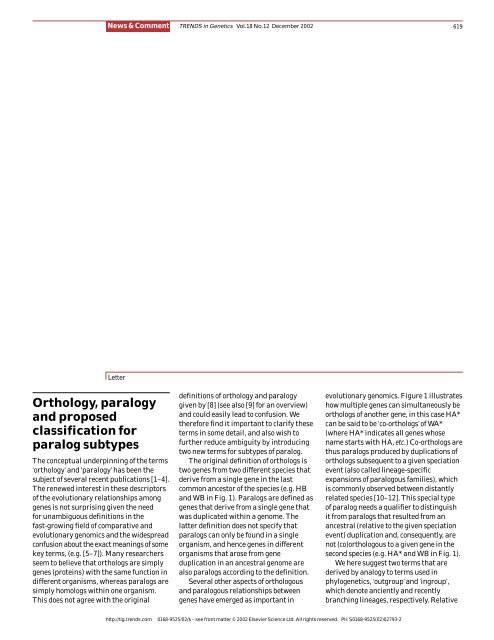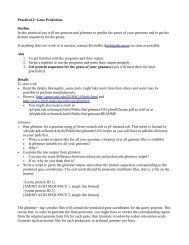Orthology, paralogy and proposed classification for paralog subtypes
Orthology, paralogy and proposed classification for paralog subtypes
Orthology, paralogy and proposed classification for paralog subtypes
You also want an ePaper? Increase the reach of your titles
YUMPU automatically turns print PDFs into web optimized ePapers that Google loves.
News & Comment<br />
TRENDS in Genetics Vol.18 No.12 December 2002<br />
619<br />
Letter<br />
<strong>Orthology</strong>, <strong><strong>paralog</strong>y</strong><br />
<strong>and</strong> <strong>proposed</strong><br />
<strong>classification</strong> <strong>for</strong><br />
<strong>paralog</strong> <strong>subtypes</strong><br />
The conceptual underpinning of the terms<br />
‘orthology’ <strong>and</strong> ‘<strong><strong>paralog</strong>y</strong>’ has been the<br />
subject of several recent publications [1–4].<br />
The renewed interest in these descriptors<br />
of the evolutionary relationships among<br />
genes is not surprising given the need<br />
<strong>for</strong> unambiguous definitions in the<br />
fast-growing field of comparative <strong>and</strong><br />
evolutionary genomics <strong>and</strong> the widespread<br />
confusion about the exact meanings of some<br />
key terms, (e.g. [5–7]). Many researchers<br />
seem to believe that orthologs are simply<br />
genes (proteins) with the same function in<br />
different organisms, whereas <strong>paralog</strong>s are<br />
simply homologs within one organism.<br />
This does not agree with the original<br />
definitions of orthology <strong>and</strong> <strong><strong>paralog</strong>y</strong><br />
given by [8] (see also [9] <strong>for</strong> an overview)<br />
<strong>and</strong> could easily lead to confusion. We<br />
there<strong>for</strong>e find it important to clarify these<br />
terms in some detail, <strong>and</strong> also wish to<br />
further reduce ambiguity by introducing<br />
two new terms <strong>for</strong> <strong>subtypes</strong> of <strong>paralog</strong>.<br />
The original definition of orthologs is<br />
two genes from two different species that<br />
derive from a single gene in the last<br />
common ancestor of the species (e.g. HB<br />
<strong>and</strong> WB in Fig. 1). Paralogs are defined as<br />
genes that derive from a single gene that<br />
was duplicated within a genome. The<br />
latter definition does not specify that<br />
<strong>paralog</strong>s can only be found in a single<br />
organism, <strong>and</strong> hence genes in different<br />
organisms that arose from gene<br />
duplication in an ancestral genome are<br />
also <strong>paralog</strong>s according to the definition.<br />
Several other aspects of orthologous<br />
<strong>and</strong> <strong>paralog</strong>ous relationships between<br />
genes have emerged as important in<br />
evolutionary genomics. Figure 1 illustrates<br />
how multiple genes can simultaneously be<br />
orthologs of another gene, in this case HA*<br />
can be said to be ‘co-orthologs’ of WA*<br />
(where HA* indicates all genes whose<br />
name starts with HA, etc.) Co-orthologs are<br />
thus <strong>paralog</strong>s produced by duplications of<br />
orthologs subsequent to a given speciation<br />
event (also called lineage-specific<br />
expansions of <strong>paralog</strong>ous families), which<br />
is commonly observed between distantly<br />
related species [10–12]. This special type<br />
of <strong>paralog</strong> needs a qualifier to distinguish<br />
it from <strong>paralog</strong>s that resulted from an<br />
ancestral (relative to the given speciation<br />
event) duplication <strong>and</strong>, consequently, are<br />
not (co)orthologous to a given gene in the<br />
second species (e.g. HA* <strong>and</strong> WB in Fig. 1).<br />
We here suggest two terms that are<br />
derived by analogy to terms used in<br />
phylogenetics, ‘outgroup’ <strong>and</strong> ‘ingroup’,<br />
which denote anciently <strong>and</strong> recently<br />
branching lineages, respectively. Relative<br />
http://tig.trends.com<br />
0168-9525/02/$ – see front matter © 2002 Elsevier Science Ltd. All rights reserved. PII: S0168-9525(02)02793-2
620 News & Comment<br />
TRENDS in Genetics Vol.18 No.12 December 2002<br />
(a)<br />
Fungal<br />
Animal<br />
A<br />
B<br />
HA1<br />
HA2<br />
HA3<br />
WA1<br />
WA2<br />
HB<br />
WB<br />
Yeast<br />
Human<br />
Worm<br />
Human<br />
Worm<br />
adaptations. This is particularly relevant<br />
<strong>for</strong> identifying functions of human genes<br />
by studying orthologs in model organisms.<br />
A real-life example of in- <strong>and</strong> out<strong>paralog</strong>s<br />
between human <strong>and</strong> fly γ-butyrobetaine<br />
hydroxylases is shown in Fig. 1b.<br />
We hope that adopting the terms<br />
in<strong>paralog</strong> <strong>and</strong> out<strong>paralog</strong> leads to an<br />
increase in clarity in genomic <strong>and</strong><br />
evolutionary publications <strong>and</strong> help avoid<br />
misleading statements on evolutionary<br />
relationships between genes.<br />
Acknowledgements<br />
We thank Walter Fitch, Roy Jensen <strong>and</strong><br />
Lennart Philipson <strong>for</strong> helpful discussions.<br />
(b)<br />
Speciation fungi–animals<br />
to a given speciation event, <strong>paralog</strong>s derive<br />
either from an ancestral duplication <strong>and</strong><br />
do not <strong>for</strong>m orthologous relationships,<br />
or they derive from a lineage-specific<br />
duplication, giving rise to co-orthologous<br />
relationships. The logical terms there<strong>for</strong>e<br />
seem to be, respectively, ‘out<strong>paralog</strong>’<strong>and</strong><br />
‘in<strong>paralog</strong>’, explicitly denoting that they<br />
are <strong>subtypes</strong> of <strong>paralog</strong>s <strong>and</strong> when they<br />
branched relative to the given speciation<br />
event. We would also consider more<br />
classical terms, such as ‘allo<strong>paralog</strong>’ <strong>for</strong><br />
out<strong>paralog</strong> <strong>and</strong> ‘sym<strong>paralog</strong>’<strong>for</strong> in<strong>paralog</strong><br />
(by analogy to allopatric <strong>and</strong> sympatric<br />
speciation), but will not use them further<br />
here <strong>for</strong> the sake of consistency.<br />
There<strong>for</strong>e, our definition of ‘in<strong>paralog</strong>s’<br />
is: <strong>paralog</strong>s in a given lineage that all<br />
evolved by gene duplications that<br />
Speciation worm–human<br />
Duplication in animal ancestor to A <strong>and</strong> B <strong>for</strong>ms<br />
YHC1_YEAST/35-458<br />
Q9NVH6/58-418<br />
Q9VDM7/1-361<br />
BODG_HUMAN/15-380<br />
Q9V6P0/26-397<br />
Q9VY24/35-405<br />
Q9W5B5/132-504<br />
S. cerevisiae<br />
H. sapiens<br />
D. melanogaster<br />
H. sapiens<br />
D. melanogaster<br />
D. melanogaster<br />
D. melanogaster<br />
TRENDS in Genetics<br />
Fig. 1. The definition of in<strong>paralog</strong>s <strong>and</strong> out<strong>paralog</strong>s. (a) Consider an ancient gene inherited in the yeast, worm <strong>and</strong><br />
human lineages. The gene was duplicated early in the animal lineage, be<strong>for</strong>e the human–worm split, into genes A<br />
<strong>and</strong> B. After the human–worm split, the A <strong>for</strong>m was in turn duplicated independently in the human <strong>and</strong> worm<br />
lineages. In this scenario, the yeast gene is orthologous to all worm <strong>and</strong> human genes, which are all co-orthologous<br />
to the yeast gene. When comparing the human <strong>and</strong> worm genes, all genes in the HA* set are co-orthologous to all<br />
genes in the WA* set. The genes HA* are hence ‘in<strong>paralog</strong>s’ to each other when comparing human to worm. By<br />
contrast, the genes HB <strong>and</strong> HA* are ‘out<strong>paralog</strong>s’ when comparing human with worm..However, HB <strong>and</strong> HA*, <strong>and</strong><br />
WB <strong>and</strong> WA* are in<strong>paralog</strong>s when comparing with yeast, because the animal–yeast split pre-dates the HA*–HB<br />
duplication. (b) Real-life example of in<strong>paralog</strong>s: γ-butyrobetaine hydroxylases. The points of speciation <strong>and</strong><br />
duplication are easily identifiable. The alignment is a subset of Pfam:PF03322 <strong>and</strong> the tree was generated by<br />
neighbor-joining in Belvu. All nodes have a bootstrap support exceeding 95%.<br />
happened after the radiation (speciation)<br />
event that separated the given lineage from<br />
the other lineage under consideration.<br />
Our definition of ‘out<strong>paralog</strong>s’is: <strong>paralog</strong>s<br />
in the given lineage that evolved by gene<br />
duplications that happened be<strong>for</strong>e the<br />
radiation (speciation) event.<br />
With more <strong>and</strong> more complete genome<br />
sequences becoming available, the<br />
genomics community is becoming aware<br />
that ‘homology’ is not a sufficiently welldefined<br />
term to describe the evolutionary<br />
relationships between genes. Emphasis is<br />
instead shifting towards identifying<br />
orthologs, which are evolutionary <strong>and</strong>,<br />
typically, functional counterparts in<br />
different species. Conversely, analysis of<br />
<strong>paralog</strong>s, particularly in<strong>paralog</strong>s, is<br />
important <strong>for</strong> detecting lineage-specific<br />
Erik L.L. Sonnhammer*<br />
Center <strong>for</strong> Genomics <strong>and</strong> Bioin<strong>for</strong>matics,<br />
Karolinska Institutet, S-17177 Stockholm,<br />
Sweden.<br />
*e-mail: Erik.Sonnhammer@cgb.ki.se<br />
Eugene V. Koonin<br />
National Center <strong>for</strong> Biotechnology<br />
In<strong>for</strong>mation, National Library of Medicine,<br />
National Institutes of Health, Bldg 38A, 8600<br />
Rockville Pike, Bethesda, MD 20894, USA.<br />
References<br />
1 Petsko, G.A. (2001) Homologuephobia. Genome<br />
Biol. 2, comment1002.1-1002.2<br />
2 Jensen, R.A. (2001) Orthologs <strong>and</strong> <strong>paralog</strong>s – we<br />
need to get it right. Genome Biol. 2, interactions1002<br />
3 Koonin, E.V. (2001) An apology <strong>for</strong> orthologs –<br />
or brave new memes. Genome Biol.<br />
2, comment1005.1–1005.2<br />
4 Theissen, G. (2002) Secret life of genes. Nature<br />
415, 741<br />
5 Gerlt, J.A. <strong>and</strong> Babbitt, P.C. (2001) Can sequence<br />
determine function Genome Biol.<br />
1, reviews0005.1–0005.10<br />
6 Fabrega, C. et al. (2001) An aminoacyl tRNA<br />
synthetase whose sequence fits into neither of the<br />
two known classes. Nature 411, 110–114<br />
7 Xie, T. <strong>and</strong> Ding, D. (2000) Investigating<br />
42 c<strong>and</strong>idate orthologous protein groups by<br />
molecular evolutionary analysis on genome scale.<br />
Gene 261, 305–310<br />
8 Fitch, W.M. (1970) Distinguishing homologous<br />
from analogous proteins. Syst. Zool. 19, 99–113<br />
9 Fitch, W.M. (2000) Homology a personal view<br />
on some of the problems. Trends Genet.<br />
16, 227–231<br />
10 Jordan, I.K. et al. (2001) Lineage-specific gene<br />
expansions in bacterial <strong>and</strong> archaeal genomes.<br />
Genome Res. 11, 555–565<br />
11 Lespinet, O. et al. (2002) The role of<br />
lineage-specific gene family expansion in the<br />
evolution of eukaryotes. Genome Res.<br />
12, 1048–1059<br />
12 Remm, M. et al. (2001) Automatic clustering of<br />
orthologs <strong>and</strong> in-<strong>paralog</strong>s from pairwise species<br />
comparisons. J. Mol. Biol. 314, 1041–1052<br />
Published online: 30 October 2002<br />
http://tig.trends.com<br />
0168-9525/02/$ – see front matter © 2002 Elsevier Science Ltd. All rights reserved.



